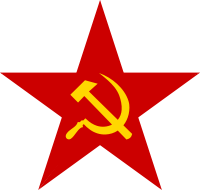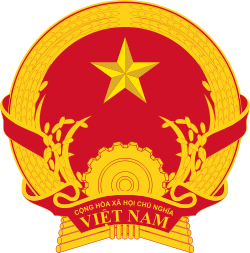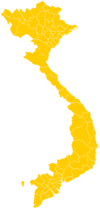Communism in Vietnam
| Part of a series on |
| Communism |
|---|
 |
|
Concepts
|
|
Internationals |
|
Related topics |
|
|
Communism in Vietnam has played a key role in the politics of Vietnam since independence. Marxism was introduced into Vietnam with the emergence of three separate communist parties; the Indochinese Communist Party, Annamese Communist Party and the Indochinese Communist Union, joined later by a Trotskyist movement led by Tạ Thu Thâu. In 1930 the Communist International (Comintern) sent Nguyễn Ái Quốc to Hong Kong to coordinate the unification of the parties into the Vietnamese Communist Party with Trần Phú as the first Secretary General.
Later the party changed its name to the Indochinese Communist Party as the Comintern, under Joseph Stalin, did not favor nationalistic sentiments. Nguyễn Ái Quốc was a leftist revolutionary living in France since 1911. He participated in founding the French Communist Party and in 1924 traveled to the Soviet Union to join the Comintern. Through the late 1920s, he acted as a Comintern agent to help build Communist movements in Southeast Asia.
During the 1930s, the Vietnamese Communist Party was nearly wiped out under French suppression with the execution of top leaders such as Phú, Lê Hồng Phong, and Nguyễn Văn Cừ.
In 1941 Nguyễn Ái Quốc, now known as Hồ Chí Minh, arrived in northern Vietnam to form the Việt Minh Front, short for Việt Nam Độc Lập Đồng Minh Hội (League for the Independence of Vietnam). The Việt Minh Front was supposed to be an umbrella group for all parties fighting for Vietnam's independence, but was dominated by the Communist Party. The Việt Minh had a modest armed force and during the war worked with the American Office of Strategic Services to collect intelligence on the Japanese. From China, other non-Communist Vietnamese parties also joined the Việt Minh and established armed forces with backing from the Kuomintang.
North Vietnam
In North Vietnam during the 1950s, political opposition groups were suppressed; those publicly opposing the government were imprisoned in hard labor camps. Many middle-class, intellectual Northerners had been lured into speaking out against Ho's communist regime, and most of them were later imprisoned in gulags, or executed, known as the Nhân Văn–Giai Phẩm affair. Prisoners were abused and beaten atop of labor-intensive work forced upon them. Many died of exhaustion, starvation, illness (who often died without any medical attention), or assault by prison guards. Between 1953 and 1956, the North Vietnamese government instituted various agrarian reforms, including "rent reduction" and "land reform", which resulted in significant political oppression. During the land reform, testimony from North Vietnamese witnesses suggested a ratio of one execution for every 160 village residents, which extrapolated nationwide would indicate nearly 100,000 executions. Because the campaign was concentrated mainly in the Red River Delta area, a lower estimate of 50,000 executions became widely accepted by scholars at the time.[1][2][3][4] However, declassified documents from the Vietnamese and Hungarian archives indicate that the number of executions was much lower than reported at the time, although likely greater than 13,500.[5]
Vietnam War
North Vietnam invaded Laos in 1959, and by 1961 had used 30,000 men to build routes through Laos and Cambodia for the purpose of invading South Vietnam.[6] About 40,000 communist soldiers infiltrated into the south from 1961–63.[7] North Vietnam sent 10,000 troops of the NVA to attack the south in 1964, and this figure increased to 100,000 in 1965.[8] By early 1965, 7,559 South Vietnamese hamlets had been destroyed by the Viet Cong.,[9]
The Vietcong are estimated to have killed about 37,000 civilians of South Vietnam between 1967, and 1972. In the peak war years, almost a third of civilian deaths were the result of Viet Cong offensives.[10] In the former capital city of Huế, Viet Cong troops captured the Imperial Citadel and much of the city, which led to the Battle of Huế. During the interim between the capture of the Citadel and end of the "Battle of Huế", the occupying forces killed 700-3,000 and possibly more Huế civilians.
Post Vietnam War
In 1975, Vietnam was officially unified and renamed Socialist Republic of Vietnam (SRVN), with its capital in Hà Nội. The Vietnamese Communist Party dropped its front name "Labor Party" and changed the title of First Secretary, a term used by China, to Secretary-General, used by the Soviet Union, with Lê Duẩn as Secretary General. The National Liberation Front was dissolved. The Party emphasised development of heavy industry and collectivisation of agriculture. Over the next few years, private enterprises and private homes were seized by the government and their owners were often sent to the New Economic Zone to clear land, often to uninhabited forested areas. Members of the Vietnamese Communist Party, North Vietnamese military or the former Viet Cong and their families were often the recipients of the confiscated properties, often in downtown areas of cities and towns. The farmers were coerced into state-controlled cooperatives. All food production was collectivized as it was in the North, forcing farmers and fishermen to sell their goods to the government at very low prices, otherwise farmers and fishermen couldn't purchase farming supplies and fishing equipment. Transportation of food and goods between provinces was deemed illegal except by the government. Within a short period of time, Vietnam was hit with severe shortage of food and basic necessities. The Mekong Delta, once a world-class rice-producing area, was threatened with famine.
In foreign relations, the SRVN became increasingly aligned with the Soviet Union by joining the Council for Mutual Economic Assistance (COMECON), and signing a Friendship Pact, which was in fact a military alliance, with the Soviet Union. Tension between Vietnam and China mounted along with China's rivalry with the Soviet Union and conflict erupted with Cambodia, China's ally. Vietnam was also subject to trade embargoes by the U.S. and its allies.
Many of those who held high positions in the old South Vietnamese government and military, together with influential people in the literary and religious circles, were sent to reeducation camps, which were actually hard labor prison camps. The inhumane conditions and treatment in the camps caused many inmates to remain bitter against the Communist Party decades later.
The SRVN government implemented a Stalinist dictatorship of the proletariat in the South as they did in the North. The network of security apparatus (Công An) controlled every aspect of people's life. Censorship was strict and ultra-conservative, with most pre-1975 works in the fields of music, art, and literature being banned. All religions had to be re-organized into state-controlled churches. Any negative comments toward the Party, the government, Uncle Ho, or anything related to Communism might earn the person the tag of Phản Động (Reactionary), with consequences ranging from being harassed by police, expelled from school or workplace, to being sent to prison. Nevertheless, the Communist authority failed to suppress the black market, where food, consumer goods, and banned literature could be bought at high prices. The security apparatus also failed to stop a nationwide clandestine network of people trying to escape the country. In many cases, the security officers of some whole districts were bribed and even got involved in organizing the escape schemes.
These living conditions resulted in an exodus of around 2.5 million Vietnamese secretly escaping the country either by sea or overland through Cambodia. Some were successful in fleeing the region and landed in numbers in Malaysia, Indonesia, the Philippines, and Hong Kong, only to wind up in United Nations refugee camps. Some famous camps were Bidong in Malaysia, Galang in Indonesia, Bataan in the Philippines and Songkla in Thailand. Some managed to travel as far as Australia in crowded, open boats.
While most refugees were resettled to other countries within five years, others languished in these camps for over a decade. In the 1990s, refugees who could not find asylum were deported back to Vietnam. Communities of Vietnamese refugees arrived in the US, Canada, Australia, France, West Germany, and the UK.
Vietnam's third Constitution, based on that of the USSR, was written in 1980. The Communist Party was stated by the Constitution to be the only party to represent the people and to lead the country.
In 1980, cosmonaut Phạm Tuân became the first Vietnamese person and the first Asian to go into space, traveling on the Soviet Soyuz 37 to service the Salyut 6 space station.
During the early 1980s, a number of overseas Vietnamese organizations were created with the aim of overthrowing the Vietnamese Communist government through armed struggle. Most groups attempted to infiltrate Vietnam but eventually were eliminated by Vietnamese security and armed forces. Most notable were the organizations led by Hoàng Cơ Minh from the US, Võ Đại Tôn from Australia, and Lê Quốc Túy from France. Hoàng Cơ Minh was killed during an ambush in Laos. Võ Đại Tôn was captured and imprisoned until his release, in December 1991. Lê Quốc Túy stayed in France for his kidney treatment while his comrades were arrested and executed in Vietnam.
Throughout the 1980s, Vietnam received nearly $3 billion a year in economic and military aid from the Soviet Union and conducted most of its trade with the USSR and other COMECON (Council for Mutual Economic Assistance) countries. Some cadres, realizing the economic suffering of the people, began to break rules and experimented with market-oriented enterprises. Some were punished for their efforts, but years later would be hailed as visionary pioneers.
Government of Vietnam
The Socialist Republic of Vietnam is a one-party state. A new state constitution was approved in April 1992, replacing the 1975 version. The central role of the Communist Party was reasserted in all organs of government, politics and society. Only political organizations affiliated with or endorsed by the Communist Party are permitted to contest elections. These include the Vietnamese Fatherland Front, worker and trade unionist parties. Although the state remains officially committed to socialism as its defining creed, the ideology's importance has substantially diminished since the 1990s. The President of Vietnam is the titular head of state and the nominal commander-in-chief of the military of Vietnam, chairing the Council on National Defense and Security. The Prime Minister of Vietnam Nguyễn Tấn Dũng is the head of government, presiding over a council of ministers composed of three deputy prime ministers and the heads of 26 ministries and commissions.
The National Assembly of Vietnam is the unicameral legislature of the government, composed of 498 members. It is superior to both the executive and judicial branches. All members of the council of ministers are derived from the National Assembly. The Supreme People's Court of Vietnam, which is the highest court of appeal in the nation, is also answerable to the National Assembly. Beneath the Supreme People's Court stand the provincial municipal courts and the local courts. Military courts are also a powerful branch of the judiciary with special jurisdiction in matters of national security. All organs of Vietnam's government are controlled by the Communist Party. Most government appointees are members of the party. The General Secretary of the Communist Party is perhaps one of the most important political leaders in the nation, controlling the party's national organization and state appointments, as well as setting policy.
See also
References
- ↑ Turner, Robert F. (1975). Vietnamese Communism: Its Origins and Development. Hoover Institution Publications. p. 143. ISBN 978-0817964313.
- ↑ cf. Gittinger, J. Price, "Communist Land Policy in Viet Nam", Far Eastern Survey, Vol. 29, No. 8, 1957, p. 118.
- ↑ Courtois, Stephane; et al. (1997). The Black Book of Communism. Harvard University Press. p. 569. ISBN 978-0-674-07608-2.
- ↑ Dommen, Arthur J. (2001), The Indochinese Experience of the French and the Americans, Indiana University Press, p. 340, gives a lower estimate of 32,000 executions.
- ↑ "Newly released documents on the land reform". Vietnam Studies Group. Archived from the original on 2011-04-20. Retrieved 2016-07-15.
Vu Tuong: There is no reason to expect, and no evidence that I have seen to demonstrate, that the actual executions were less than planned; in fact the executions perhaps exceeded the plan if we consider two following factors. First, this decree was issued in 1953 for the rent and interest reduction campaign that preceded the far more radical land redistribution and party rectification campaigns (or waves) that followed during 1954-1956. Second, the decree was meant to apply to free areas (under the control of the Viet Minh government), not to the areas under French control that would be liberated in 1954-1955 and that would experience a far more violent struggle. Thus the number of 13,500 executed people seems to be a low-end estimate of the real number. This is corroborated by Edwin Moise in his recent paper "Land Reform in North Vietnam, 1953-1956" presented at the 18th Annual Conference on SE Asian Studies, Center for SE Asian Studies, University of California, Berkeley (February 2001). In this paper Moise (7-9) modified his earlier estimate in his 1983 book (which was 5,000) and accepted an estimate close to 15,000 executions. Moise made the case based on Hungarian reports provided by Balazs, but the document I cited above offers more direct evidence for his revised estimate. This document also suggests that the total number should be adjusted up some more, taking into consideration the later radical phase of the campaign, the unauthorized killings at the local level, and the suicides following arrest and torture (the central government bore less direct responsibility for these cases, however).
cf. Szalontai, Balazs (November 2005). "Political and Economic Crisis in North Vietnam, 1955–56". Cold War History. 5 (4): 395–426. - ↑ The Economist, 26 February 1983.
- ↑ Ang, Cheng Guan (2002). The Vietnam War from the Other Side. RoutledgeCurzon. p. 76. ISBN 0-7007-1615-7.
- ↑ Washington Post, 23 April 1985.
- ↑ Reader's Digest "The Blood-Red Hands of Ho Chi Minh", November 1968.
- ↑ Guenter Lewy, America in Vietnam (Oxford University Press, 1978), pp272-3, 448-9.

